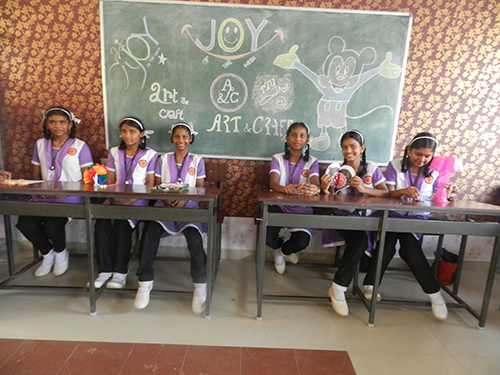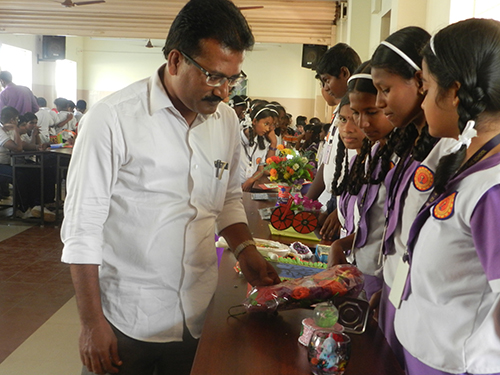Creative Art
Creative Art
We are a very creative school and the Art and Design Departments is a magnet for our artistic and design orientated students. Starting from KG, students participate in the Visual Arts Program. The Visual Arts Program at School allows students to express feelings and ideas while making connections to the world around them. Students experiment with various mediums, including digital art. Projects include clay animals, origami and a lot more. Students’ various works of art are displayed throughout the school in their respective classes during the year, but they are also featured in the culminating Action day event. This exhibit showcases their natural and creative talents. At School students are taught Visual Art using a balanced approach where they engage in art making activities, learn about art history, have opportunities to critique art, and reflect on their learning. Students strengthen their abilities to plan their ideas first and then work through the design and creative processes to complete a work of art. Both this creative process and several finished works are documented in each student’s art book.
Students have the opportunity to dab their brushes in paint, sketch from observation and imagination, roll brayers in ink to make prints, make scissors dance creating collages, squeeze and roll clay, and work with a wide range of other materials to create both . Students explore a range of fine art styles and techniques throughout Grades 1 to 12, and also learn about crafts from a wide variety of cultures and countries. The curriculum is enhanced by Arts Field trips, giving students a chance to experience art and art-making in a variety of settings outside the school, from museums to mountains.. Through this collaboration, the students’ creativity truly blossoms as they are able to see an idea connect through visual art, music, dance, and drama.
The Visual Arts curriculum is designed to build skills, techniques, and understandings within the arts as they progress through the grade levels. Over time, the students’ understanding of how to use a variety of materials, work in various techniques, see art across time and cultures, and develop their own ideas and expressions will also grow.
There’s no question that the arts are fun for children. Diving right into those finger paints and also making a gorgeous picture to hang on the fridge is awesome. Performing in a play is thrilling. Yet the arts also assist children establish on numerous basic levels.
Below are the top ten ways that the arts assist kids discover as well as create crucial qualities they will certainly require as grownups:
- Imagination.
This might seem like a piece of cake, but the arts enable children to share themselves far better than mathematics or scientific research.. If children have technique believing creatively, it will certainly come normally to them now and also in their future job.
- Boosted Academic Performance.
The arts do not just develop a kid’s imagination– the abilities they discover as a result of them spill over into academic accomplishment
- Motor Abilities.
This uses mainly to younger children who do art or play an instrument. Simple points like holding a paintbrush as well as doodling with a pastel are a crucial element to developing a kid’s great electric motor skills. Inning accordance with the National Institutes of Wellness, developing landmarks around age 3 should consist of drawing a circle and beginning to make use of security scissors. Around age four, children could have the ability to attract a square and also start reducing straight lines with scissors.
- Confidence.
While grasping a subject certainly constructs a student’s self-confidence, there is something special regarding participating in the arts. Obtaining up on a phase and vocal singing provides kids a possibility to tip outside their comfort area. As they boost as well as see their own progress, their self-esteem will certainly continue to grow.
- Visual Learning.
Especially for young children, drawing, paint, and also sculpting in art class aid establish visual-spatial skills. Art education instructs pupils the best ways to analyze, criticize, as well as make use of aesthetic info, and how to make choices based upon it.
- Decision Making.
The arts enhance issue addressing and vital reasoning abilities. Exactly how do I express this feeling with my dancing? How should I play this personality? Discovering ways to choose and decisions will definitely carry over right into their education and also other components of life– as this is certainly an useful ability in the adult years.
- Willpower.
I know from individual experience that the arts could be challenging. When I was trying to learn and grasp the clarinet, there were often times when I ended up being so frustrated that I wished to give up. However I didn’t. After practicing hard, I discovered that hard work as well as perseverance pay off. This mindset will certainly matter as they grow– particularly throughout their career where they will likely be asked to consistently establish new abilities as well as overcome difficult tasks.
- Focus.
As you stand firm through paint or vocal singing or discovering a component in a play, focus is vital. As well as definitely emphasis is vital for researching and learning in class as well as doing a job later in life.
- Collaboration.
Many of the arts such as band, choir, as well as theater need children to interact. They should share duty and compromise to accomplish their typical goal. Children learn that their payment to the group is important to its success– even if they do not have the solo or lead role.
- Accountability.
Just like cooperation, children in the arts learn that they are answerable for their contributions to the team. If they drop the ball or ruin, they understand that it is essential to take duty of what they did. Blunders belong of life, and also discovering how to approve them, repair them, and move on will offer children well as they get older.



